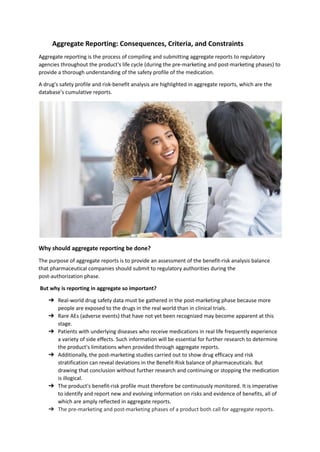
Aggregate Reporting: Consequences, Criteria, and Constraints
- 1. Aggregate Reporting: Consequences, Criteria, and Constraints Aggregate reporting is the process of compiling and submitting aggregate reports to regulatory agencies throughout the product's life cycle (during the pre-marketing and post-marketing phases) to provide a thorough understanding of the safety profile of the medication. A drug's safety profile and risk-benefit analysis are highlighted in aggregate reports, which are the database's cumulative reports. Why should aggregate reporting be done? The purpose of aggregate reports is to provide an assessment of the benefit-risk analysis balance that pharmaceutical companies should submit to regulatory authorities during the post-authorization phase. But why is reporting in aggregate so important? ➔ Real-world drug safety data must be gathered in the post-marketing phase because more people are exposed to the drugs in the real world than in clinical trials. ➔ Rare AEs (adverse events) that have not yet been recognized may become apparent at this stage. ➔ Patients with underlying diseases who receive medications in real life frequently experience a variety of side effects. Such information will be essential for further research to determine the product's limitations when provided through aggregate reports. ➔ Additionally, the post-marketing studies carried out to show drug efficacy and risk stratification can reveal deviations in the Benefit-Risk balance of pharmaceuticals. But drawing that conclusion without further research and continuing or stopping the medication is illogical. ➔ The product's benefit-risk profile must therefore be continuously monitored. It is imperative to identify and report new and evolving information on risks and evidence of benefits, all of which are amply reflected in aggregate reports. ➔ The pre-marketing and post-marketing phases of a product both call for aggregate reports.
- 2. ➔ In both the pre-marketing and post-marketing phases of a product, these aggregate reports are necessary. These reports each pinpoint and emphasize a distinct risk or benefit. The following list includes the overall reports for each stage. Aggregate reports are categorized as follows. Aggregate Reporting Constraints ➔ Compiling aggregate reports and submitting them legally can be challenging due to the nature of the process. ➔ Due to the wide variety of reports that must be included in the submission, the documentation process is frequently quite difficult. Even though switching to electronic platforms has made sorting reports easier, it is still difficult. ➔ In a broader sense, scheduling and assigning tasks among the workforce by choosing the appropriate resource for each process continues to be a problem that needs to be solved. ➔ Aggregate reporting is still a labor-intensive manual process even after the proper resources have been allocated and tracking it with spreadsheets might make it even more disorganized. ➔ There must be consistency in any report updates. The regulatory team, the safety and clinical team, and the marketing team, among others, must provide timely updates on information from various stakeholders. Each report must be tracked from submission to approval by pharmaceutical companies. They must also recognize and check the line listings for accuracy, considering the variety of data involved. ➔ The reporting process involves enormous amounts of data, and those amounts keep growing every day. The risks of errors leading to non-compliance findings are a major source of worry for the pharmaceutical industry. ➔ In addition to all these difficulties, regional regulatory requirements are a common worry. The regulatory guidelines are periodically revised in stages and are not consistent worldwide, necessitating the use of multiple trackers for various products and nations. ➔ Companies are still realizing that some of these issues can be resolved through the harmonization of regulations, on which the international regulatory bodies are still working.
- 3. They enable improved coordination and quick data access. It reduces the time needed to file the data for submission while improving search criteria and sorting capabilities. ➔ Pharmaceutical companies will discover that automating regulatory reporting lifecycle management will improve quality in authoring, and will ensure that reviews are completed in time, providing respite to stakeholders. The complexity of aggregate reporting is on the rise. Important Product Features ➢ Schedule Management for Reports ➢ Predefined templates for PADER, PSUR, PBRER, DSUR, CTPR, and other documents ➢ Electronic Authoring ➢ Collaboratively examine activities based on workflow. ➢ Regulatory Surveillance ➢ Version Control Access Control ➢ Rule Auto Update ➢ Sharing Combined Reports ➢ Notifications and alerts ➢ Analytics and Insights Sollers provides certificates for graduates in the Advanced Drug Safety and Pharmacovigilance Program. This unique program was developed for professionals who want to work in the field of drug safety and is based on the popular, business-based Oracle Argus Safety Database Software. Pharmacovigilance is currently the focus of the healthcare industry to balance risks and benefits. With Sollers, take the next step toward achieving your professional goals. Build and hone skills that will distinguish your resume by learning in-demand life science skills. An essential tool for analyzing the benefit-risk balance of a medicinal product over the course of its life cycle is aggregate reporting. Reference: https://sollers.edu/aggregate-reporting-consequences-criteria-and-constraints/
